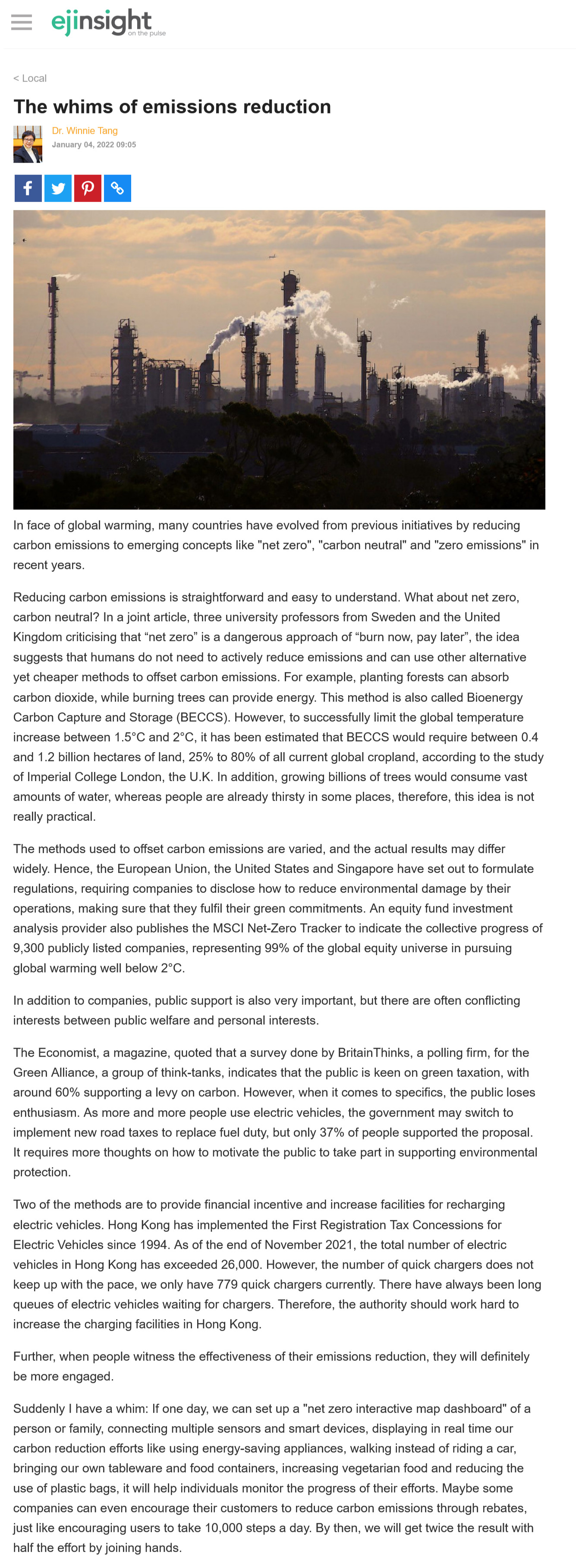網上版請按此

The whims of emissions reduction
In face of global warming, many countries have evolved from previous initiatives by reducing carbon emissions to emerging concepts like "net zero", "carbon neutral" and "zero emissions" in recent years.
Reducing carbon emissions is straightforward and easy to understand. What about net zero, carbon neutral? In a joint article, three university professors from Sweden and the United Kingdom criticising that "net zero" is a dangerous approach of "burn now, pay later", the idea suggests that humans do not need to actively reduce emissions and can use other alternative yet cheaper methods to offset carbon emissions. For example, planting forests can absorb carbon dioxide, while burning trees can provide energy. This method is also called Bioenergy Carbon Capture and Storage (BECCS). However, to successfully limit the global temperature increase between 1.5°C and 2°C, it has been estimated that BECCS would require between 0.4 and 1.2 billion hectares of land, 25% to 80% of all current global cropland, according to the study of Imperial College London, the U.K. In addition, growing billions of trees would consume vast amounts of water, whereas people are already thirsty in some places, therefore, this idea is not really practical.
The methods used to offset carbon emissions are varied, and the actual results may differ widely. Hence, the European Union, the United States and Singapore have set out to formulate regulations, requiring companies to disclose how to reduce environmental damage by their operations, making sure that they fulfil their green commitments. An equity fund investment analysis provider also publishes the MSCI Net-Zero Tracker to indicate the collective progress of 9,300 publicly listed companies, representing 99% of the global equity universe in pursuing global warming well below 2°C.
In addition to companies, public support is also very important, but there are often conflicting interests between public welfare and personal interests.
The Economist, a magazine, quoted that a survey done by BritainThinks, a polling firm, for the Green Alliance, a group of think-tanks, indicates that the public is keen on green taxation, with around 60% supporting a levy on carbon. However, when it comes to specifics, the public loses enthusiasm. As more and more people use electric vehicles, the government may switch to implement new road taxes to replace fuel duty, but only 37% of people supported the proposal. It requires more thoughts on how to motivate the public to take part in supporting environmental protection.
Two of the methods are to provide financial incentive and increase facilities for recharging electric vehicles. Hong Kong has implemented the First Registration Tax Concessions for Electric Vehicles since 1994. As of the end of November 2021, the total number of electric vehicles in Hong Kong has exceeded 26,000. However, the number of quick chargers does not keep up with the pace, we only have 779 quick chargers currently. There have always been long queues of electric vehicles waiting for chargers. Therefore, the authority should work hard to increase the charging facilities in Hong Kong.
Further, when people witness the effectiveness of their emissions reduction, they will definitely be more engaged.
Suddenly I have a whim: If one day, we can set up a "net zero interactive map dashboard" of a person or family, connecting multiple sensors and smart devices, displaying in real time our carbon reduction efforts like using energy-saving appliances, walking instead of riding a car, bringing our own tableware and food containers, increasing vegetarian food and reducing the use of plastic bags, it will help individuals monitor the progress of their efforts. Maybe some companies can even encourage their customers to reduce carbon emissions through rebates, just like encouraging users to take 10,000 steps a day. By then, we will get twice the result with half the effort by joining hands.
Dr. Winnie Tang
Adjunct Professor, Department of Computer Science, Faculty of Engineering; Department of Geography, Faculty of Social Sciences; and Faculty of Architecture, The University of Hong Kong